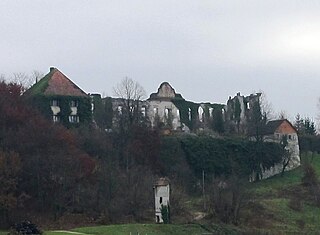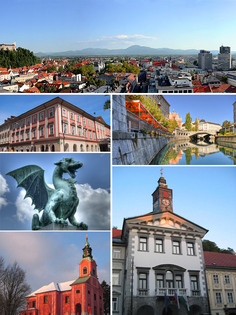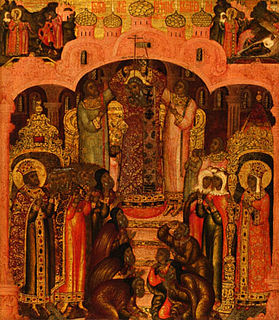
Ivančna Gorica is a settlement and a municipality in central Slovenia. It is part of the traditional region of Lower Carniola and is now included in the Central Slovenia Statistical Region.

Janče is a dispersed settlement in the hills south of the Sava River east of the capital Ljubljana in central Slovenia. It belongs to the City Municipality of Ljubljana. It was part of the traditional region of Lower Carniola and is now included with the rest of the municipality in the Central Slovenia Statistical Region.

Spodnje Gameljne is a village on the right bank of the Sava River north of the capital Ljubljana in central Slovenia. It belongs to the City Municipality of Ljubljana. It was part of the traditional region of Upper Carniola and is now included with the rest of the municipality in the Central Slovenia Statistical Region.

Gabrska Gora is a settlement south of Gabrovka in the Municipality of Litija in central Slovenia. Traditionally the area was part of Lower Carniola and is now included with the rest of the municipality in the Central Sava Statistical Region; until January 2014 the municipality was part of the Central Slovenia Statistical Region. It includes the hamlets of Gora, Stari Boršt, Gabrje, and Turn.

Mamolj is a settlement in the hills east of Litija in central Slovenia. Traditionally the area was part of Lower Carniola and is now included with the rest of the Municipality of Litija in the Central Sava Statistical Region. It includes the hamlets of Spodnji Mamolj, Zgornji Mamolj, Čebelnik, Češek, Podmilj, Resnarica, and Trinkavs.

Vodice pri Gabrovki is a settlement north of Gabrovka in the Municipality of Litija in central Slovenia. Traditionally the area was part of Lower Carniola and is now included with the rest of the municipality in the Central Sava Statistical Region. The settlement includes the hamlets of Zgornje Vodice, Spodnje Vodice, and Greben.

Rodež is a village in the Municipality of Zagorje ob Savi in central Slovenia. The area is part of the traditional region of Lower Carniola. It is now included with the rest of the municipality in the Central Sava Statistical Region. The village includes the hamlets of Klenovik and Boriče.

Rovišče is a settlement in the Municipality of Zagorje ob Savi in central Slovenia. The area is part of the traditional region of Upper Carniola. It is now included with the rest of the municipality in the Central Sava Statistical Region. It includes the hamlet of Zasavska Gora, also known as Sveta Gora.

Podstran is a settlement north of Moravče in central Slovenia. Traditionally the area was part of Upper Carniola. It is now included with the rest of the Municipality of Moravče in the Central Slovenia Statistical Region. It includes the hamlet of Sveti Mohor.

Zdenska Vas is a village north of Videm in the Municipality of Dobrepolje in Slovenia. The area is part of the historical region of Lower Carniola. The municipality is now included in the Central Slovenia Statistical Region.

Žalna is a settlement in the Municipality of Grosuplje in central Slovenia. It lies southeast of Grosuplje in the historical region of Lower Carniola. The municipality is now included in the Central Slovenia Statistical Region. It includes the hamlets of Prevale, Velika Žalna, and Mala Žalna, as well as part of the hamlet of Na Šoli.

Veliko Mlačevo is a village in the Municipality of Grosuplje in central Slovenia. It lies just southeast of Grosuplje itself in the historical region of Lower Carniola. The municipality is now included in the Central Slovenia Statistical Region. The settlement includes the hamlet of Boštanj south of the main settlement.

Stična is a village in the Municipality of Ivančna Gorica in central Slovenia. The area is part of the historical region of Lower Carniola. The municipality is now included in the Central Slovenia Statistical Region. It lies just north of Ivančna Gorica and is best known for its Cistercian Abbey. The abbey dates to the 12th century and is the oldest monastery in Slovenia. It includes the hamlets of Rupe, Štorovje, and Svinjska Vas. A former hamlet named Kaffeehaus also stood between Svinjska Vas and Rupe.

Bukovica is a village in the Municipality of Ivančna Gorica in central Slovenia. The area is part of the historical region of Lower Carniola. The municipality is now included in the Central Slovenia Statistical Region. It includes the hamlets of Brezovec, Cerovec, Gornji Vrh, Potok, and Ukajdol.

Gabrje pri Stični is a settlement just north of Stična in the Municipality of Ivančna Gorica in central Slovenia. The area is part of the historical region of Lower Carniola. The municipality is now included in the Central Slovenia Statistical Region. The settlement includes the hamlets of Kurja Vas, Potok, Pungrt, and Nograd.

Pristava nad Stično is a small settlement in the hills north of Stična in the Municipality of Ivančna Gorica in central Slovenia. The area is part of the historical region of Lower Carniola. The municipality is now included in the Central Slovenia Statistical Region.

Gradišče, officially Gradišče - K. o. Grad. in Polj., is a small settlement in the Municipality of Šmartno pri Litiji in central Slovenia. The area is part of the historical region of Lower Carniola. The municipality is now included in the Central Slovenia Statistical Region. It includes the hamlets of Kremenjek and Primskova Gora.

Osredek pri Krmelju is a settlement northwest of Krmelj in the Municipality of Sevnica in central Slovenia. The area is part of the historical region of Lower Carniola. The municipality is now included in the Lower Sava Statistical Region. It includes the hamlets of Rupa, Radvanca, Dobovec, Gabrje, Komatca, Oplaz, Kij, and Prinštal.

Glinica is a former settlement in central Slovenia in the northwest part of the capital Ljubljana. It belongs to the Dravlje District of the City Municipality of Ljubljana. It was part of the traditional region of Upper Carniola and is now included with the rest of the municipality in the Central Slovenia Statistical Region.

Boštanj is a formerly independent settlement in the southern part of the village of Veliko Mlačevo in central Slovenia. It belongs to the Municipality of Grosuplje. It was part of the traditional region of Lower Carniola and is now included with the rest of the municipality in the Central Slovenia Statistical Region.




















